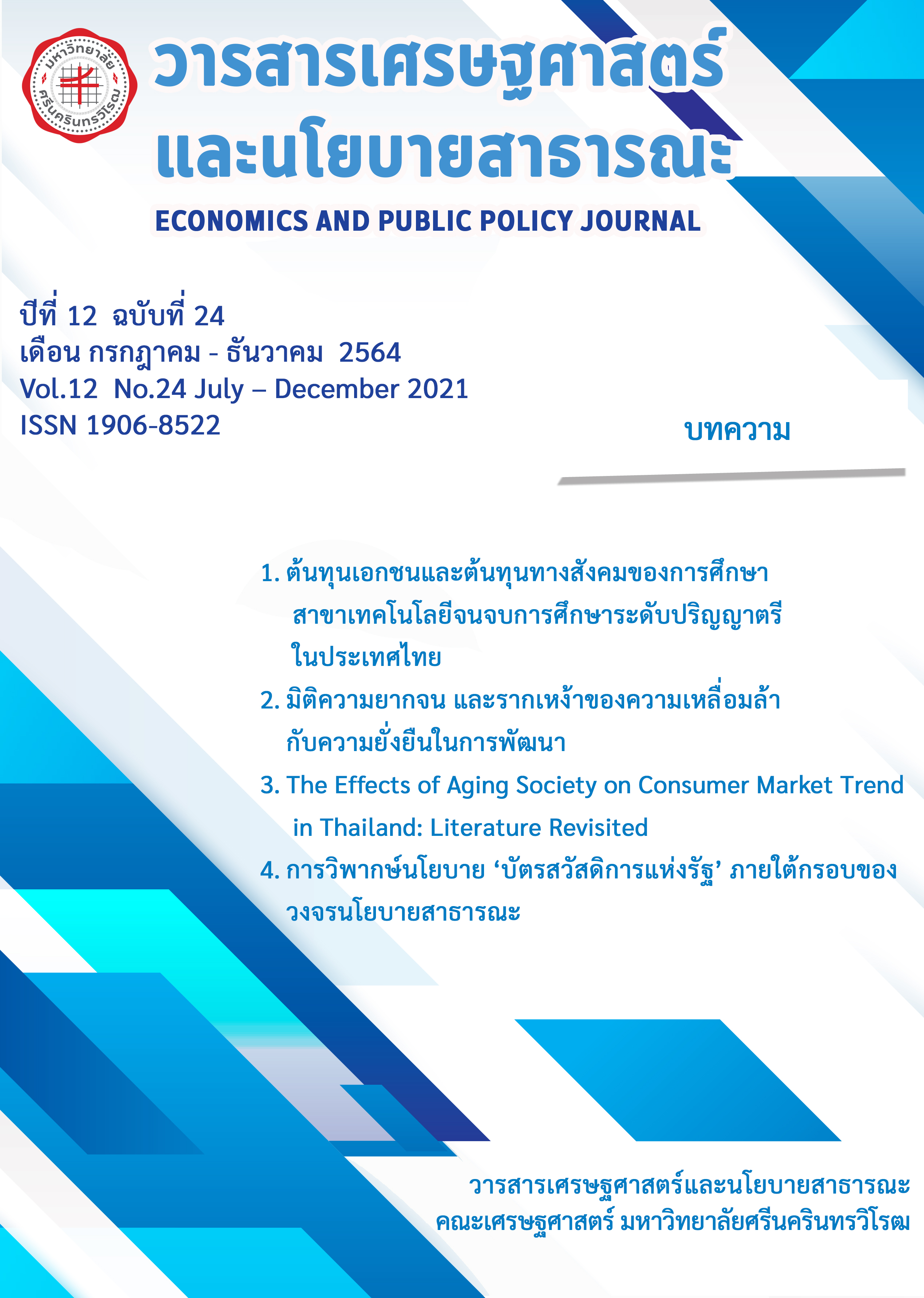ต้นทุนเอกชนและต้นทุนทางสังคมของการศึกษาสาขาเทคโนโลยีจนจบการศึกษาระดับปริญญาตรี ในประเทศไทย
Main Article Content
บทคัดย่อ
การวิจัยครั้งนี้มีวัตถุประสงค์เพื่อวิเคราะห์ต้นทุนเอกชนและต้นทุนทางสังคมของการศึกษาสาขาเทคโนโลยีตั้งแต่ระดับประถมศึกษาจนจบการศึกษาระดับปริญญาตรีในประเทศไทย เก็บรวบรวมข้อมูลของนักเรียนกลุ่มตัวอย่างที่ศึกษาระดับปฐมศึกษา มัธยมศึกษา ประกาศนียบัตรวิชาชีพ (ปวช.) และประกาศนียบัตรวิชาชีพขั้นสูง (ปวส.)
ในจังหวัดนครปฐม และนักศึกษาที่เรียนระดับปริญญาตรีในมหาวิทยาลัยเทคโนโลยีพระจอมเกล้าพระนครเหนือ
เขตบางซื่อ กรุงเทพมหานคร เก็บรวบรวมข้อมูลปฐมภูมิโดยจากการสังเกตพฤติกรรมของกลุ่มตัวอย่างและใช้ข้อมูล
ทุติยภูมิของหน่วยงานเกี่ยวข้องในช่วงปีงบประมาณ พ.ศ. 2561
ผลการศึกษาพบว่าครัวเรือนมีต้นทุนสำหรับการศึกษาระดับประถมศึกษา (6 ปี) ระดับมัธยมศึกษาตอนต้น (3 ปี) ระดับมัธยมศึกษาตอนปลาย (3 ปี) ระดับ ปวช. (3 ปี) ระดับ ปวส. (2 ปี) คิดเป็นมูลค่าปัจจุบันเท่ากับ 106,358 บาทต่อ คน 135,200 บาทต่อ คน 141,553 บาทต่อคน 160,440 บาทต่อคน และ 114,219 บาทต่อคน ตามลำดับ ส่วนต้นทุนสำหรับการศึกษาระดับปริญญาตรีหลักสูตรต่อเนื่อง 2 ปี หลักสูตรต่อเนื่อง 3 ปี และหลักสูตร 4 ปี มีมูลค่าปัจจุบันเท่ากับ 416,826 บาทต่อคน 669,658 บาทต่อคน และ 931,206 บาทต่อคน ตามลำดับ ทั้งนี้ ต้นทุนรวมของครัวเรือนสำหรับการศึกษาสาขาเทคโนโลยีตั้งแต่ระดับประถมศึกษาจนจบการศึกษาระดับมัธยมศึกษาตอนปลาย ระดับ ปวช. และระดับปวส. มีมูลค่าปัจจุบันเท่ากับ 383,111 บาท 401,998 บาท และ 516,217 บาท ตามลำดับ ส่วนต้นทุนรวมสำหรับการศึกษาจนจบปริญญาตรีในประเทศไทย มีมูลค่าปัจจุบันเท่ากับ 933,043 - 1,333,204 บาท ต้นทุนที่รัฐบาลรับภาระสำหรับการศึกษาระดับประถมศึกษา มัธยมศึกษา ปวช. และ ปวส. มีมูลค่าประมาณ 20,000 - 25,000 บาทต่อคนต่อปี ส่วนการศึกษาระดับปริญญาตรีมีต้นทุนที่รัฐบาลรับภาระประมาณ 77,444 บาทต่อคนต่อปี ต้นทุนทางสังคมของการศึกษาระดับประถมศึกษาเท่ากับ 35,706 บาทต่อคนต่อปี ต้นทุนทางสังคมของการศึกษาระดับมัธยมศึกษาต้อนต้น มัธยมศึกษาตอนปลาย ปวช. และ ปวส. อยู่ระหว่าง 60,000 – 80,000 บาทต่อคนต่อปี ขณะที่ต้นทุนทางสังคมของการศึกษาระดับปริญญาตรีเท่ากับ 285,500 บาทต่อคนต่อปี
Article Details

อนุญาตภายใต้เงื่อนไข Creative Commons Attribution-NonCommercial-NoDerivatives 4.0 International License.
สงวนลิขสิทธิ์ © 2553 คณะเศรษฐศาสตร์ มหาวิทยาลัยศรีนครินทรวิโรฒ
คณะเศรษฐศาสตร์ มหาวิทยาลัยศรีนครินทรวิโรฒ จัดพิมพ์วารสารเศรษฐศาสตร์และนโยบายสาธารณะ เพื่อเผยแพร่บทความวิชาการทางเศรษฐศาสตร์ นโยบายสารธารณะ และสาขาอื่นๆที่เกี่ยวข้อง ทัศนะและข้อคิดเห็นใดๆ ที่ปรากฏในวารสารเป็นความคิดเห็นส่วนตัวของผู้เขียน โดยบทความที่ได้รับการตอบรับจะถือเป็นลิขสิทธิ์ของคณะเศรษฐศาสตร์ มหาวิทยาลัยศรีนครินทรวิโรฒ
บรรณาธิการ อาจารย์ ดร.พลพัธน์ โคตรจรัส
เอกสารอ้างอิง
ภาษาไทย
กระทรวงแรงงาน. (2559). กรอบยุทธศาสตร์ การพัฒนาทรัพยากรมนุษย์ของประเทศ ระยะ 20 ปี (พ.ศ. 2560-2579). [ออนไลน์]. [สืบค้นวันที่ 1 กรกฎาคม 2561] จาก https://www.nstda.or.th/th/nstda-doc-archives/thailand-40/11704-ministryoflabour.
ธนาคารแห่งประเทศไทย. (2561). เครื่องชี้เศรษฐกิจมหภาคของไทย. [สืบค้นวันที่ 1 กรกฎาคม 2561] จาก https://www.bot.or.th/App/BTWS_STAT/statistics/ReportPage.aspx?reportID=409&language=th.
มหาวิทยาลัยเทคโนโลยีพระจอมเกล้าพระนครเหนือ. (2561). สถิตินักศึกษา ปีการศึกษา 2561. [ออนไลน์]. [สืบค้นเมื่อวันที่ 4 มกราคม 2562]. จาก http://acdserv.kmutnb.ac.th/regis_2561
_________. (2562). อัตราค่าธรรมเนียมการศึกษา ระดับปริญญาตรี ปีการศึกษา 2558. [ออนไลน์]. [สืบค้นเมื่อวันที่ 4 มกราคม 2562]. จาก http://acdserv.kmutnb.ac.th/tuition-fee-undergraduate
สำนักงบประมาณของรัฐสภา. (2561). รายงานการวิเคราะห์ของสำนักงบประมาณของรัฐสภา ฉบับที่ 4/2561 เปรียบเทียบงบประมาณรายจ่ายประจำปีงบประมาณ พ.ศ. 2560-2562. [ออนไลน์]. [สืบค้นวันที่ 6 สิงหาคม 2562] จาก https://www.parliament.go.th/ewtadmin/ewt/parbudget/ewt_dl_link.php?nid=509
สำนักงานปลัดกระทรวงศึกษาธิการ สำนักงานศึกษาธิการภาค 4. (2561). รายงานข้อมูลสารสนเทศ และดัชนีทางการศึกษาระดับภาค สำนักงานศึกษาธิการภาค 4 ปีการศึกษา 2561. [ออนไลน์]. [สืบค้นวันที่ 6 สิงหาคม 2562] จาก http://www.reo3.moe.go.th/web/images/news/annoucement/10012020.pdf
สำนักงานศูนย์วิจัยและให้คำปรึกษาแห่งมหาวิทยาลัยธรรมศาสตร์. (2563). โครงการวิจัยและพัฒนาระบบบัญชีรายจ่ายด้านการศึกษาแห่งชาติ ประจำปีงบประมาณ 2551-2561. [ออนไลน์]. [สืบค้นเมื่อวันที่ 31 ตุลาคม 2563] จาก https://research.eef.or.th/research/area-based-education-management-project-for-educational-equality-nea/
สำนักงานสภาพัฒนาการเศรษฐกิจและสังคมแห่งชาติ. (2562). ผลิตภัณฑ์ภาคและจังหวัด แบบปริมาณลูกโซ่ อนุกรมเวลา 2538-2562. [ออนไลน์]. [สืบค้นเมื่อวันที่ 6 สิงหาคม 2562] จาก https://www.nesdc.go.th/main.php?filename=gross_regional
ภาษาอังกฤษ
Atkinson, Thomas., Liem, Ramsay. And Liam, Joan, H. (1986). The Social Costs of Unemployment: Implications for Social Support, Journal of Health and Social Behavior, Vol. 27 (December): 317-331
Coase, R. H. (1960). The Problem of Social Cost, The Journal of Law & Economics, Oct., 1960, Vol. 3 (Oct., 1960), pp. 1-44.
Elsner, Wolfram; Frigato, Pietro; Ramazzotti, Paolo (eds.) (2006), Social Costs and Public Action in Modern Capitalism: Essays Inspired by Karl William Kapp’s Theory of Social Costs. London: Routledge.
Everett Johnson Burtt, Jr. (1972). Social Perspectives in the History of Economic Theory, St. Martin’s Press, Now York, 1972, p. 274. Referred to in Steven N. S. Cheung. (1992). The Myth of Social Cost A critique of welfare economics and the implications for public policy, Third Impression 1992. London, UK: The Institute of Economic Affairs.
Federal Reserve Bank of San Francisco. (2002). What is the difference between private and social costs, and how do they relate to pollution and production?. Retrieved on December 2021, from https://www.frbsf.org/education/publications/doctor-econ/2002/november/private-social-costs-pollution-production/
Field, Barry C., (1997). Environmental Economics: An Introduction. Irwin/McGraw-Hill, Boston.
Frischmann, Brett M. and Marciano, Alain. (2015). Understanding the Problem of Social Cost, Journal of Institutional Economics (2015), 11:2, 329-352.
Institute for Policy Integrity. (2017). Social Costs of Greenhouse Gases. Retrieved on December 5, 2021, from https://www.edf.org/sites/default/files/social_cost_of_greenhouse_gases_factsheet.pdf
Ismail, Ramlee, Awang, Marinah and Mohd Noor, Mohd Asri. (2016). Analysis of Private and Social Costs of Education in Malaysia: An Overview, International Journal of Academic Research in Business and Social Sciences, Vol. 6, No. 11, pp. 24-37.
Knight, F.H. (1924). Some Fallacies in the Interpretation of Social Cost, The Quarterly Journal of Economics, vol. 38, issue 4, 582-606.
Lu, Jackson G. (2020). Air pollution: A systematic review of its psychological, economic, and social effects, Current Opinion in Psychology, Volume 32, April 2020, Pages 52-65.
Medema, Steven (1996), “On Pangloss, Pigouvians and Pragmatism: Ronald Coase and Social Cost Analysis,” Journal of the History of Economic Thought, 18 (Spring): 96-114.
Mincer, J. (1984). "Human capital and economic growth," Economics of Education Review, vol 3(3), pages 195-205.
Pigou A. C. (1912). Wealth and Welfare. London: Macmillan and Company. Referred to in Steven N. S. Cheung. (1992). The Myth of Social Cost A critique of welfare economics and the implications for public policy, Third Impression 1992. London, UK: The Institute of Economic Affairs.
Pigou A.C. (1932). The Economics of Welfare, London, UK: Macmillan. Referred to in Steven N. S. Cheung. (1992). The Myth of Social Cost A critique of welfare economics and the implications for public policy, Third Impression 1992. London, UK: The Institute of Economic Affairs.
Rani, H. Osman (2007). The Cost of Schooling: Does it Matter?, Journal Pendidikan Bitara UPSI, Vol. 1 No. 1 June 2007, pp. 81-93.
Rennert, Kevin. And Kingdon, Cora. (2019). Social Cost of Carbon 101 A review of the social cost of carbon, from a basic definition to the history of its use in policy analysis, Resources for the Future. Retrieved on December 5, 2021, from https://www.rff.org/publications/explainers/social-cost-carbon-101/
Runco, M.A., Hao, N., Acar, S., Yang, J., and Tang, M. (2016). The Social “Cost” of Working in Groups and Impact on Values and Creativity, Creativity. Theory-Research-Applictions, Vol. 3, Issue 2, pp. 229-243.
Steven N. S. Cheung. (1992). The Myth of Social Cost A critique of welfare economics and the implications for public policy, Third Impression 1992. London, UK: The Institute of Economic Affairs.
Thomas Atkinson, Ramsay Liem and Joan H. Liem. (1986). The Social Costs of Unemployment: Implications for Social Support, Journal of Health and Social Behavior Vol. 27, No. 4 (Dec., 1986), pp. 317-331.
Wolla, Scoot A. and Sullivan, Jessica. (2017). Education, Income, and Wealth, Economic Research Federal Reserve Bank of St. Louis. Retrieved on December 2021, from https://research.stlouisfed.org/publications/page1-econ/2017/01/03/education-income-and-wealth/


